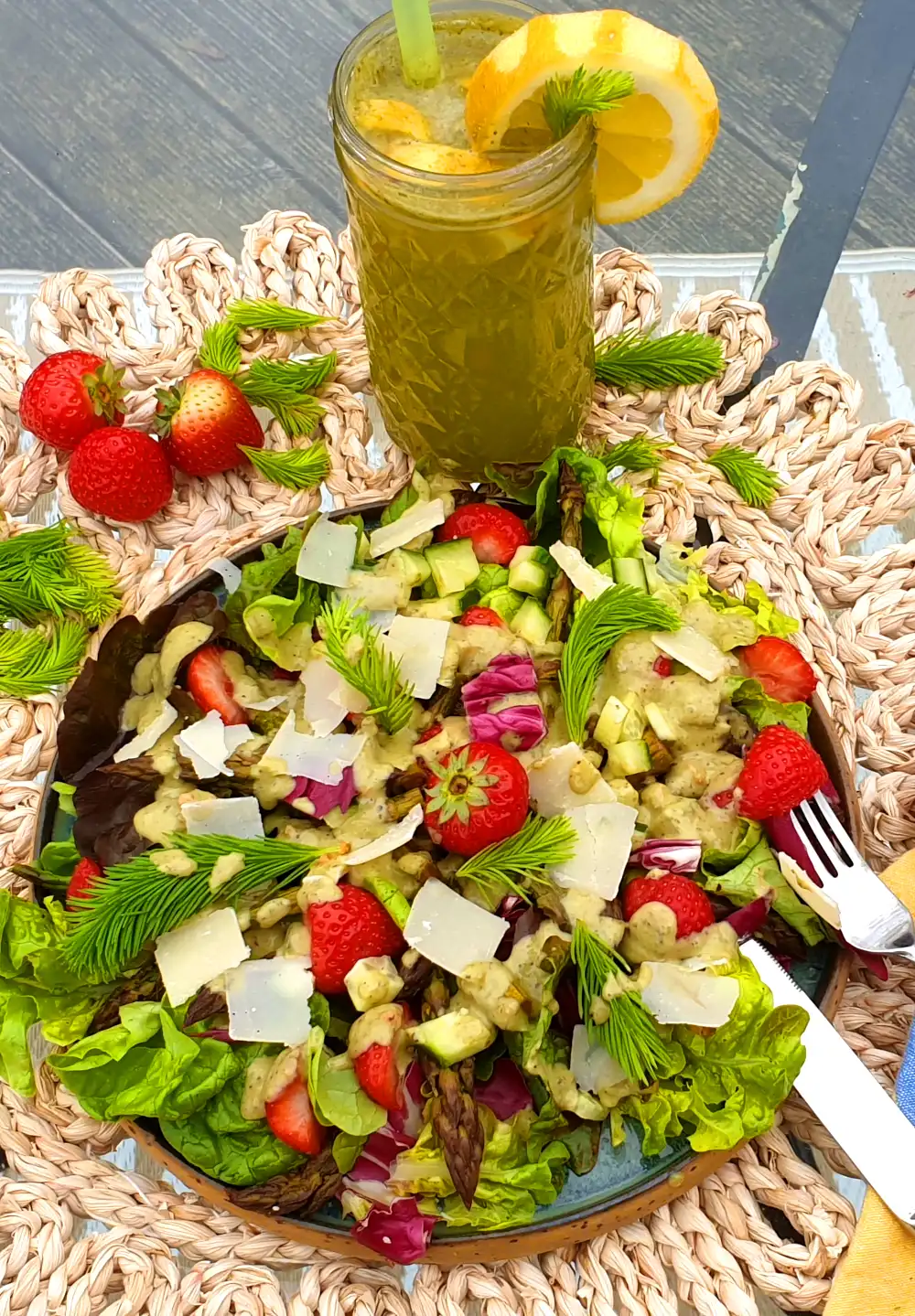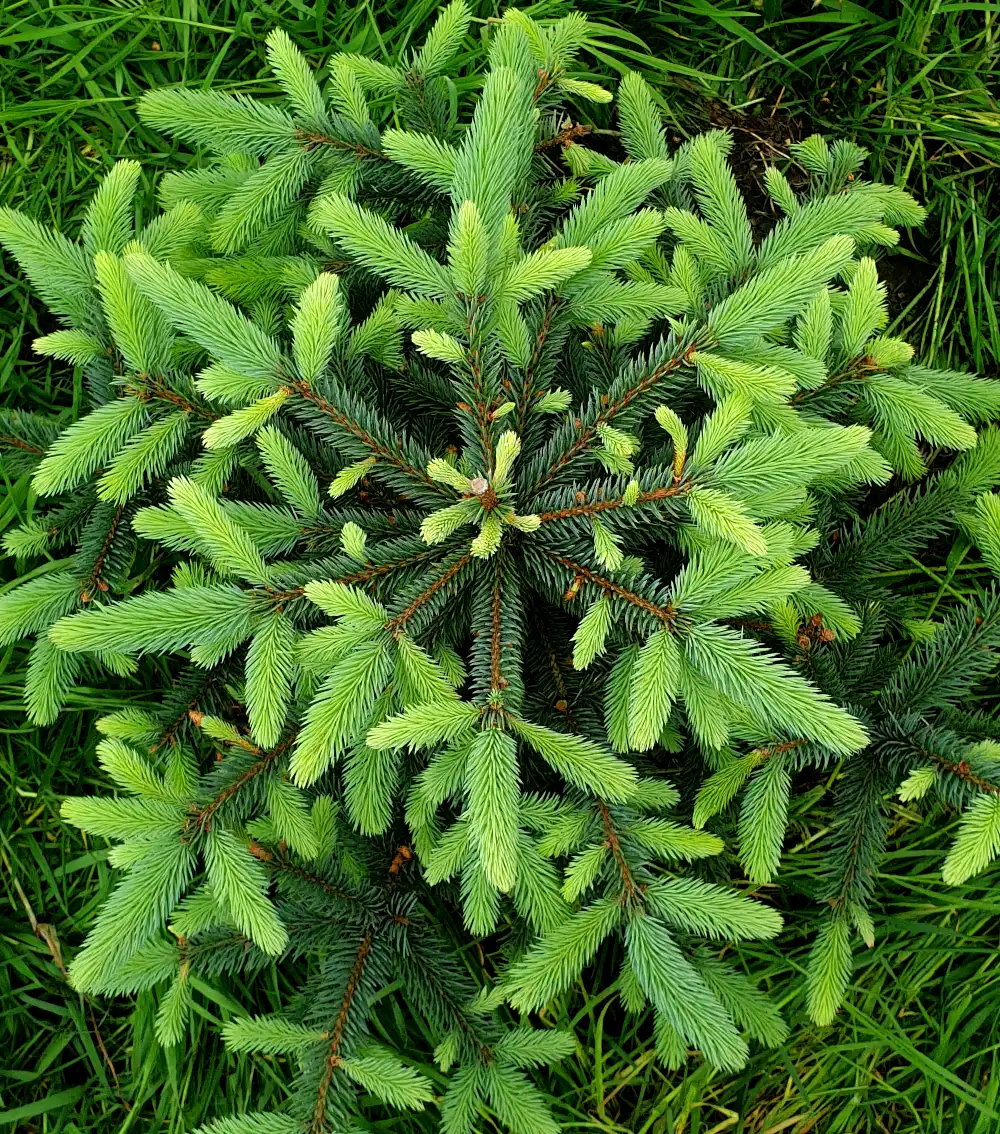Green asparagus and strawberry salad with Maiwipferl dressing
- Vegan option* - Gluten-free - Lactose-free
Preparation time: 45 min - Difficulty level: easy
Ingredients Salad, for 2 portions as a main meal:
- 1 handful of freshly picked spruce shoots (maiwipferl)
- mixed lettuce (you can also use head radiccio lollo or arugula)
- 500 g green asparagus
- 250 g strawberries halved
- ½ cucumber
- 2 tbsp olive oil
- 50 g Parmesan thinly sliced * 2 tbsp roasted sunflower seeds
Ingredients Dressing:
- 125 g sour cream or *vegan version
- 1 tbsp lemon juice
- 2 tbsp orange juice
- 1 tbsp spruce sprout powder
- 1 tsp medium-hot mustard
- 1-2 tbsp honey or agave*
- 2 tbsp olive oil
- fleur de sel, freshly ground pepper


The delicate, light green shoots of the spruce tree are called "Maiwipferl". Their young shoot tips are so rich in vitamin C and tender that they can be eaten raw in salads. We have also conjured up a dressing with our spruce shoot powder. When collecting, it is best to shake them out so that you don't take any "forest dwellers" home with you.
Salad preparation:
Remove the woody ends from the asparagus and cut it diagonally into thumb-sized pieces, putting the heads to one side. The green asparagus is actually so fine that you don't need to peel it, at most at the bottom ends.
Then pick the lettuce leaves, wash, spin dry and tear into bite-sized pieces.
Now wash and sort the strawberries, remove the green parts and cut them in half.
Wash the cucumber, cut into small cubes, drain and wash the spruce shoots and leave to dry individually on a kitchen towel.
Then finely grate the Parmesan or, for the vegan version, briefly toast the sunflower seeds in a pan without oil. Heat the olive oil in a pan and sauté the asparagus pieces - except the heads - in it, tossing repeatedly. They should be crispy and lightly browned. This takes about 6-8 minutes. Add your asparagus heads just before the end.
If you prefer the asparagus softer, simply fry for longer.
Preparation of the Maiwipferl dressing:
Now for the Maiwipferl dressing, put all the ingredients in a jar with a screw-on lid and shake vigorously until there are no more lumps and season to taste.
Arrange the salad on plates and arrange the asparagus pieces, strawberries and cucumber on top, pour the dressing evenly over it and top everything with Parmesan shavings or self-service seeds and your Maiwipferl.
Do you like a quick and tangy spruce lemonade to go with it?
Whisk 1 teaspoon of spruce sprout powder with mineral water for each glass, add fresh lemon and ice cubes if desired. Done!

The spruce is not only able to survive harsh winters, it also provides people with vitamin C, which is in short supply during the cold season. The vitamin C content of the needles is so high that in the past, tea was brewed from them to treat sailors suffering from scurvy who arrived in the freezing cold Nordic countries after a long, often stormy voyage.
After the spruce needle tea had saved their lives, they might have felt like decorating the blessed tree, whether it was Christmas or not.
Every spring, new growth appears at the tips of the shoots, surrounded by a papery sheath that falls off as the shoots grow. The young shoot tips are so tender that they can be eaten raw in salads.
However, they become hard after just a few days, but are still suitable for infusions, tea or flavoring.
Spruces have four-sided, needle-fine leaves that can remain on the tree for up to 10 years. In contrast to other conifers, spruce needles grow individually on the branches.
Distribution: Worldwide, various species of spruce are native to almost every country in the world.
Habitat: Spruces grow almost everywhere, except on very dry or nutrient-poor soil (they are also numerous in our local Reichswald forest).
Collection times: All year round - the needles and from May to June their tender needles and young cones.
Cooking tip: All spruce species have a light citrus aroma, which can vary from grapefruit to lemon and goes equally well with sweet and savory dishes.
Very young spruce tips are so tender that they can be added raw to salads in small quantities, and the aroma also goes very well with butter sauces. The flavor is lost through prolonged cooking, so spruce tips should only be added at the end of the cooking time, just like fresh herbs. Young spruce tips taste delicious in ice cream, sorbet, pickled in honey and in pastries. Slightly older ones can be chopped up and used in seasoning salt or sugar and make wonderfully relaxing teas. The young shoots can be preserved in syrup or vinegar or used in mineral water to make a refreshing summer lemonade.
You can also freeze the sprouts, as they will not lose their unique aroma.
Caution: Spruces are conifers, many conifers have edible parts, only the yew is highly poisonous. So if you want to collect parts of conifers for the kitchen, you should be able to recognize and exclude yew with absolute certainty.